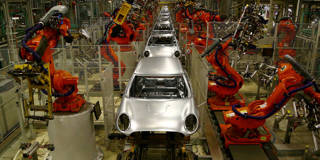As the COVID-19 pandemic escalates, the advanced economies seem to be geared up for a manufacturing renaissance. But while this may reduce risks for large firms, it probably will not benefit very many advanced-economy workers, let alone the developing countries from which production is being shifted.
MUNICH – As the COVID-19 pandemic escalates, the risks inherent in global supply chains are more apparent than ever. Rather than await a return to business as usual, with manufacturing activities concentrated in countries where labor is cheap and plentiful, advanced-economy companies are shifting their focus to the lowest-wage workers of all: robots.
Firms began relocating production to low-wage countries in the early 1990s, aided by the fall of the Iron Curtain, China’s global integration and eventual accession to the World Trade Organization, and the rise of containerization. The period between 1990 and the 2008 global financial crisis has been called an era of hyper-globalization in which global value chains accounted for about 60% of global trade.
The 2008 global financial and economic crisis marked the beginning of the end of this era of hyper-globalization. In 2011, global value chains stopped expanding. They have not grown again since.

MUNICH – As the COVID-19 pandemic escalates, the risks inherent in global supply chains are more apparent than ever. Rather than await a return to business as usual, with manufacturing activities concentrated in countries where labor is cheap and plentiful, advanced-economy companies are shifting their focus to the lowest-wage workers of all: robots.
Firms began relocating production to low-wage countries in the early 1990s, aided by the fall of the Iron Curtain, China’s global integration and eventual accession to the World Trade Organization, and the rise of containerization. The period between 1990 and the 2008 global financial crisis has been called an era of hyper-globalization in which global value chains accounted for about 60% of global trade.
The 2008 global financial and economic crisis marked the beginning of the end of this era of hyper-globalization. In 2011, global value chains stopped expanding. They have not grown again since.